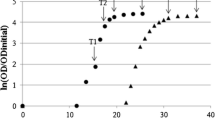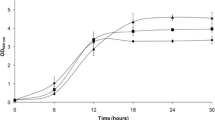Abstract
The effects of stress shocks on the freeze-drying viability, malolactic activity and membrane fatty acid composition of the Oenococcus oeni SD-2a cells were studied. O. oeni SD-2a cells after 2 h of stress exposure exhibited better freeze-drying viability and malolactic fermentation ability. A decrease in unsaturated fatty acids/saturated fatty acids (UFA/SFA) ratio and in the C18:1 relative concentration, and an increase in cyclopropane fatty acids (CFA) content mainly due to the increase in C19cyc11 relative concentration were observed in all stress shocked cells. There was a significant negative correlation between C19cyc11 and C18:lcis11, C16:0 in all stress shocks. The freeze-drying viability exhibited a significant positive correlation with the levels of C19cyc11 in cold and acid shocks. The only significant positive correlation between the ability of O. oeni SD-2a to conduct malic acid degradation and membrane composition existed with C14:0 in ethanol shocks. In general, freeze-drying viabilities were maximum for cells with low UFA/SFA ratio and high CFA levels, and, consequently, with low membrane fluidity. Moreover, CFA formation played a major role in protecting stress shocked cells from lyophilization. However, changes observed in membrane fatty acid composition are not enough to explain the greater freeze-drying viability of cells shocked at 8% ethanol. Thus, other mechanisms could be responsible for this increase in the bacterial resistance to lyophilization.

Similar content being viewed by others
References
Álvarez-Ordóñez A, Fernández A, López M, Arenas R, Bernardo A (2008) Modifications in membrane fatty acid composition of Salmonella typhimurium in response to growth conditions and their effect on heat resistance. Int J Food Microbiol 123:212–219
Álvarez-Ordóňez A, Fernández A, López M, Bernardo A (2009) Relationship between membrane fatty acid composition and heat resistance of acid and cold stressed Salmonella senftenberg CECT 4384. Food Microbiol 26:347–353
Annous BA, Kozempel MF, Kurantz MJ (1999) Changes in membrane fatty acid composition of Pediococcus sp. strain NRRL B-2354 in response to growth conditions and its effect on thermal resistance. Appl Environ Microbiol 65:2857–2862
Beal C, Fonseca F, Corrieu G (2001) Resistance to freezing and frozen storage of Streptococcus thermophilus is related to membrane fatty acid composition. J Dairy Sci 84:2347–2356
Beltramo C, Desroche N, Tourdot-Maréchal R (2006) Real-time PCR for characterizing the stress response of Oenococcus oeni in a wine-like medium. Res Microbiol 157:267–274
Brown JL, Ross T, McMeekin TA, Nichols PD (1997) Acid habituation of Escherichia coli and the potential role of cyclopropane fatty acids in low pH tolerance. Int J Food Microbiol 37:163–173
Carvalho AS, Silva J, Ho P, Teixeira P, Malcata FX, Gibbs P (2004) Relevant factors for the preparation of freeze-dried lactic acid bacteria. Int Dairy J 14:835–847
Casadei MA, Mañas P, Niven G, Needs E, Mackey BM (2002) Role of membrane fluidity in pressure resistance of Escherichia coli NCTC 8164. Appl Environ Microbiol 68:5965–5972
Chang YY, Cronan JE (1999) Membrane cyclopropane fatty acid content is a major factor in acid resistance of Escherichia coli. Mol Microbiol 33:249–259
Chu-Ky S, Tourdot-Marechal R, Marechal PA, Guzzo J (2005) Combined cold, acid, ethanol shocks in Oenococcus oeni: effects on membrane fluidity and cell viability. Biochim Biophys Acta 1717:118–124
Cosette G, Assad-García JS, Chu-Ky S, Tollot M, Guzzo J, Tourdot-Maréchal R (2008) Changes in membrane lipid composition in ethanol-and acid-adapted Oenococcus oeni cells: characterization of the cfa gene by heterologous complementation. Microbiol 154:2611–2619
da Silveira MG, Golovina EA, Hoekstra FA, Rombouts FM, Abee T (2003) Membrane fluidity adjustments in ethanol-stressed Oenococcus oeni cells. Appl Environ Microbiol 69:5826–5832
da Silveira MG, Baumgartner M, Rombouts FM, Abee T (2004) Effect of adaptation to ethanol on cytoplasmic and membrane protein profiles of Oenococcus oeni. Appl Environ Microbiol 70:2748–2755
Drici-Cachon Z, Guzzo J, Cavin JF, Diviès C (1996) Effect of pH and age of culture on cellular fatty acid composition of Leuconostoc oenos. Lett Appl Microbiol 44:785–789
Fernández ML, Cabrera G, Font de Valdez A, Disalvo A, Seldes AM (2000) Influence of growth temperature on cryotolerance and lipid composition of Lactobacillus acidophilus. J Appl Microbiol 88:342–348
Garbay S, Lonvaud-Funel A (1996) Response of Leuconostoc oenos to environmental changes. J Appl Bacteriol 81:619–625
Garbay S, Rozes N, Lonvaud-Funel A (1995) Fatty acid composition of Leuconostoc oenos, incidence of growth conditions and relationship with malolactic efficiency. Food Microbiol 12:387–395
Gómez ZA, Disalvo EA, De Antoni GL (2000) Fatty acid composition and freeze-thaw resistance in lactobacilli. J Dairy Res 67:241–247
Guillot A, Obis D, Mistou MY (2000) Fatty acid membrane composition and activation of glycine–betaine transport in Lactococcus lactis subjected to osmotic stress. Int J Food Microbiol 55:47–51
Li H, Zhang CH, Liu YL (2006) Species attribution and distinguishing strains of Oenococcus oeni isolated from Chinese wines. World J Microbiol Biotechnol 22:515–518
Li C, Zhao JL, Wang YT, Han X, Liu N (2009a) Synthesis of cyclopropane fatty acid and its effect on freeze-drying survival of Lactobacillus bulgaricus L2 at different growth conditions. World J Microbiol Biotechnol 25:1659–1665
Li H, Zhao WY, Wang H, Li ZC, Wang AL (2009b) Influence of culture pH on freeze-drying viability of Oenococcus oeni and its relationship with fatty acid composition. Food Bioprod Process 87:56–61
Lonvaud-Funel A (1999) Lactic acid bacteria in the quality improvement and depreciation of wine. Antonie van Leeuwenhoek 76:317–331
Machado MC, Lopez CS, Heras H, Rivas EA (2004) Osmotic response in Lactobacillus casei ATCC 393: biochemical and biophysical characteristics of membrane. Arch Biochem Biophys 422:61–70
Maicas S (2001) The use of alternative technologies to develop malolactic fermentation in wine. Appl Microbiol Biotechnol 56:35–39
Maicas S, Pardo I, Ferrer S (2000) The effects of freezing and freeze-drying of Oenococcus oeni upon induction of malolactic fermentation in red wine. Int J Food Sci Technol 35:75–79
Montanari C, Kamdema SL, Serrazanetti DI, Etbo FX, Guerzoni ME (2010) Synthesis of cyclopropane fatty acids in Lactobacillus helveticus and Lactobacillus sanfranciscensis and their cellular fatty acids changes following short term acid and cold stresses. Food Microbiol 27:493–502
Muňoz-Rojas J, Bernal P, Duque E, Godoy P, Segura A (2006) Involvement of cyclopropane fatty acids in the response of Pseudomonas putida KT2440 to freeze-drying. Appl Environ Microbiol 72:472–477
Nielsen JC, Parhl C, Lonvaud-Funel A (1996) Malolactic fermentation in wine by direct inoculation with freeze-dried Leuconostoc oenos cultures. Am J Enol Viticul 47:42–48
Palmfeldt J, Hahn Hagerdal B (2000) Influence of culture pH on survival of Lactobacillus reuteri subjected to freeze-drying. Int J Food Microbiol 55:235–238
Rozes N, Garbay S, Denayrolles M, Lonvaud-Funel A (1993) A rapid method for the determination of bacterial fatty acid composition. Lett Appl Microbiol 17:126–131
Schoug Å, Fischer J, Hermann JH, Schnürer J, Håkansson S (2008) Impact of fermentation pH and temperature on freeze-drying survival and membrane lipid composition of Lactobacillus coryniformis Si3. J Ind Microbiol Biotechnol 35:175–181
Sico MA, Bonomo MG, D’Adamo A, Bochicchio S, Salzano G (2009) Fingerprinting analysis of Oenococcus oeni strains under stress conditions. FEMS Microbiol Lett 296:11–17
Spano G, Massa S (2006) Environmental stress response in wine lactic acid bacteria: beyond Bacillus subtilis. Crit Rev Microbiol 32:77–86
Taranto MP, Fernandez ML, Lorca G, de Valdez GF (2003) Bile salts and cholesterol induce changes in the lipid cell membrane of Lactobacillus reuteri. J Appl Microbiol 95:86–91
Teixeira H, Goncalves MG, Rozes N, Ramos A, San Romao MV (2002) Lactobacillic acid accumulation in the plasma membrane of Oenococcus oeni: a response to ethanol stress? Microb Ecol 43:146–153
Terrade N, Noël R, Couillaud R, de Orduña RM (2009) A new chemically defined medium for wine lactic acid bacteria. Food Res Int 42:363–367
Tymczyszyn EE, Gomez-Zavaglia A, Disalvo EA (2005) Influence of the growth at high osmolality on the lipid composition, water permeability and osmotic response of Lactobacillus bulgaricus. Arch Biochem Biophys 443:66–73
van de Guchte M, Serror P, Chervaus C, Smokvina T, Ehrlich ST, Maguin E (2002) Stress responses in lactic acid bacteria. Antonie van Leeuwenhoek 82:187–216
Versari A, Parpinello GP, Cattaneo M (1999) Leuconostoc oenos and malolactic fermentation in wine: A review. J Ind Microbiol Biotechnol 23:447–455
Wang Y, Corrieu G, Beal C (2005) Fermentation pH and temperature influence the cryotolerance of Lactobacillus acidophilus RD758. J Dairy Sci 88:21–29
Zhao G, Zhang G (2009) Influences of protectants, rehydration media and storage on the viability of freeze-dried Oenococcus oeni for malolactic fermentation. World J Microbiol Biotechnol 25:1801–1806
Author information
Authors and Affiliations
Corresponding author
Rights and permissions
About this article
Cite this article
Zhang, G., Fan, M., Lv, Q. et al. The effect of cold, acid and ethanol shocks on synthesis of membrane fatty acid, freeze-drying survival and malolactic activity of Oenococcus oeni . Ann Microbiol 63, 477–485 (2013). https://doi.org/10.1007/s13213-012-0492-x
Received:
Accepted:
Published:
Issue Date:
DOI: https://doi.org/10.1007/s13213-012-0492-x




